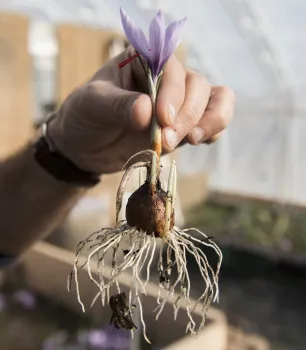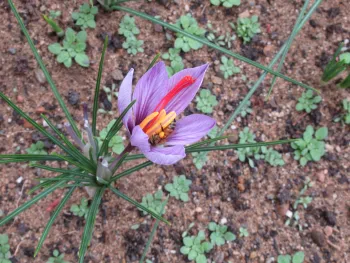
Saffron is one of the most expensive spices in the world—but did you know you can grow it right in your own backyard? With a little effort and patience, Marin home gardeners can cultivate Crocus sativus, the plant that produces saffron, even in containers or raised beds. This fall-blooming flower grows well in Marin’s Mediterranean climate, making it a great choice for those looking to add something special to their home garden.
Saffron comes from the bright red stigmas (threads) of the Crocus sativus flower. To grow your own, you'll need to buy corms online or at specialty garden stores during late summer.

When buying, larger is better. Big corms, corms that are 3.5" (9cm) or greater in circumference, can produce two to four flowers. More flowers mean more saffron.
Saffron can be grown in containers, raised beds, or directly in the ground.
- Containers are great for patios and small spaces. Choose a pot that’s at least 12" deep.
- Raised beds offer excellent drainage and make it easier to manage weeds. Hardware cloth or weed cloth at the base of the bed deters pest damage.
- In-ground planting works well if your soil drains properly, but beware of pests.
An especially creative method that works well in Marin is using milk crates lined with weed cloth. This setup gives your corms plenty of drainage while keeping the soil contained and weed-free and keeps pests out. Just fill the crate with a well-draining soil mix.
If planting in the ground, watch out for gophers, voles, and other burrowing pests, which may dig up or damage your corms. Wire mesh or underground baskets can help protect your crop. Deer also enjoy eating the flower and leaves of Crocus sativus.
Plant saffron corms about six inches deep and four inches apart in late August or September, before the rainy season begins. This gives them time to settle in and send up leaves before flowering in late October or November. Avoid overcrowding, as that reduces production.
Saffron corms will sprout leaves soon after planting. Flowers usually appear in mid to late fall, around 6–8 weeks after planting. Each flower only lasts a day or two, so you’ll need to check your plants daily when they start blooming. Saffron doesn’t like too much water. If it is an especially rainy season, consider covering with plastic or moving to a protected area.

Each Crocus sativus flower has three red stigmas, which is the saffron you’ll harvest. Pick the flowers early in the morning, just after they open. Use tweezers or your fingers to gently remove the threads.
To preserve the saffron, dry the threads in a 200 degree oven for seven to ten minutes. Once dried, store them in an airtight container away from light. A little saffron goes a long way. Just a few threads can flavor an entire dish of paella or risotto.
After the flowers are harvested, the plant will continue growing green leaves through winter and early spring. These leaves feed the corm, helping it produce new baby corms underground. Don’t cut the leaves, they’ll die back naturally in late spring or early summer.
Once the leaves yellow and dry, you can either leave the corms in the ground or dig them up to divide and replant next season. If you planted in containers or crates, store them in a cool, dry place until fall.
Stay in touch with saffron growers around the world. Join the Saffron Email List Saffronnet. This is an international internet network established by the North American Center of Saffron Research and Development for those interested in growing saffron or learning more about ongoing research and other related initiatives. https://www.uvm.edu/~saffron/pages/saffronnet.html
By Jill Heiman Williams, September 13, 2025

